|
Me Sahyadri |
|
December 2019 |
|
Volume 6, number 12, # 89 |
|
Nageshwar Temple |
Please use minimum 1280 pixel horizontal screen resolution for viewing. Please be patient while all the images in webpage are loaded. Please do not use the images for any commercial use without permission. Text in Marathi and English is not exact translation. Please give sufficient time to allow the photographs to load. Special thanks to Ninad Bartakke and Saili Palande Datar and all those who helped me during the compilation and for the help and guidance during the activity. |
|
|
|
|
देशाची आर्थिक प्रगती व्हावी असे सर्व नागरिकांना वाटणे सहाजिक आहे. अर्थकारणामुळे मिळणारा रोजगार, समृद्धी यासाठी सर्वांनाच आर्थिक प्रगती हवी हवीशी वाटते. आर्थिक प्रगती होताना, त्याचा दिर्घकाळात समाजावर, निसर्गावर, वातावरणावर दुष्परिणाम होणार नाही याची काळजी घेणे महत्वाचे आहे. मनुष्याच्या भावी पिढ्यांना पाणी, शुद्ध हवा, योग्य वातावरण मिळत रहावे अशी भावना मनात रुजणे महत्वाचे आहे. वाढत्या आर्थिक प्रगतीमुळे नैसर्गिक संपदेवर ताण येतो. प्रगतीसाठी प्रदुषण होते. जंगले, माळराने, व इतर अधिवास नष्ट होतात. वसुंधरेवर रहाणाऱ्या इतर जीवांचा मात्र मनुष्य फारसा विचार करत नाही. आर्थिक प्रगती करताना, मनुष्य निसर्गाची हानी करत आहे. मुळताच माणसाला निसर्गाचे महत्व समजणे हे सध्याच्या आपल्या प्रगत जीवनशैली मुळे अवघड झाले आहे. आर्थिक प्रगती, समाजाची प्रगती व निसर्ग संपदेची निगा, यांचा समतोल राखणे काळाची गरज आहे.
सह्याद्री (पश्चिम घाट) हा एक नैसर्गिक संपदेचा, वैविध्यतेचा, भौगोलिक व ऐतिहासिक ठेवा आहे. वाढत्या मानवी अतिक्रमणाचा, सह्याद्रीच्या विविध घटकांवर होणारा दुष्परिणाम भविष्यात आपल्यालाच धोका निर्माण करेल, यात शंका नाही. शुद्ध पाणी, हवा व उर्जा, भावी पिढीला मिळण्यासाठी, नंद्यांचे उगम असलेला सह्याद्री व त्याभागातील जंगले टिकवणे महत्वाचे आहे. सह्याद्रीच्या महत्वाच्या घटकांचे महत्व छायाचित्रांद्वारे प्रकट करण्याचा मी येथे प्रयत्न केला आहे. येथील पक्षी, प्राणी, वनस्पती, अधिवास, किल्ले व लेणी अशा विविध विषयांबद्दल आपण समजुन घेऊ.
|
|
As the economic development has taken the center stage, the balance between the environmental sustenance and socio economic development will be under the scanner. As most experts with balanced views have proclaimed, Indian wildlife and ecological system sustenance will be under threat, unless precautions are taken with the help of appropriate research and long term national interests. As we encounter the economic development, many habitats which indirectly or directly help sustainable development will be damaged. The awareness to gauge the success by sustainable development and not by year to year growth is a distant dream any environmentalist will assume in current scenario.
Western ghats, or Sahyadri as we all call it as, is a treasure trove of spectacular landscapes, biodiversity, flora, fauna, some amazing geological wonders and man made monuments. With the increasing pressure from human encroachment, all these elements are under stress and in turn are under depletion. Western ghats should be left untouched by human beings, to protect their future generations from getting short of resources, such as water, energy and clean air. The important elements of western ghats, which need protection are highlighted in the new version of Photo journal, Me Sahyadri Magazine.
|
|
|
| |
 
|
| |
| Me Sahyadri – December 2019
|
| |
|
|
| |
  |
| The banner has been published here to improve the awareness of the trekkers and tourists visiting the various mountain forts, mountains in north western ghats. Please avoid accidents, by following good outdoor ethics such as no swimming in cisterns at mountain forts, no rock climbing without proper technical equipment and expertise. Please do not adventure, trek with any group or individually without understanding the risks associated. The frequency of the solo trekker fatalities have increased recently. Please strictly avoid solo treks. Please also avoid treks to mountains in large commercial groups, as it leads to damage to biodiversity of these high elevation ecological islands. Please respect the wildlife and biodiversity of the region. This has become more important as the ever increasing human interference is leading to severe damage to fragile ecosystems. Please be aware of the wildlife and biodiversity of the mountains before visiting these mountains. Please follow outdoor ethics. Follow ASI and Forest department rules. The concept of use of symbols for outdoor ethics was conceived and designed by "Sahyadri Trekker Bloggers Group". |
| |
|
|
| |
  |
| |
| 1. NageshwarTemple region map, Maharashtra, India |
| |
|
|
खिरेश्वर गाव पुणे जिल्ह्याच्या जुन्नर तालुल्यात आहे. खिरेश्वर जुन्नर पासुन २७ किलोमीटर अंतरावर तर पुणे शहरापासुन अंदाजे १२० किलोमीटर अंतरावर आहे. खिरेश्वर गाव दखनच्या पठारावर घाटमाथ्य्वार हरिश्चंद्रगडाच्या डोंगरारांगेच्या पायथ्याशी वसलेले आहे. हरिश्चंद्रगड डोंगरारांगेच्या उत्तरेला गोदावरी खोरे तर दक्षिणेला भीमा नदीचे खोरे असुन ही रांग अंदाजे ४५ किलोमीटर आंतरापर्यंत पसरलेली आहे. या डोंगररांगेच्या दक्षिणेला हटकेश्वर डोंगररांग पश्चिम पुर्व पसरलेली आहे. खिरेश्वर गावाजवळ काळु आणि पुष्पावती नदयांचा उगम होतो. हरिश्चंद्रगड आणि हटकेश्वर या दोन डोंगररांगांच्या मधल्या पठारावरुन पुष्पावती नदी पुर्वेकडे वाहते. काळु नदी पश्चिमेकडे कोकणात उतरते. पुष्पावती नदी नंतर कुकडी आणि त्यातुन भीमेला मिळते. तर काळु नदी कोकणात उल्हास नदीला जाऊन मिळते.
|
|
Khireshwar village is located in Junnar tehsil in Pune district in Maharashtra state in India, at about 27 km north west of Junnar and about 120 km from Pune city center. Khireshwar is located on the deccan plateau at the base of the Harishchandragad range. The hill range is a part of the extension of the Sahyadri main ridge on the Deccan plateau divides the Godavari and Bhima river basins. Spread in west–east orientation, this hill range, which is about 45 kilometer in length, spread to the east from the Harishchandragad at western ghat ridge. South of this hill range there is a parallel Hatakeshwar range. Between Harishchandragad hill range and Hatakeshwar and Harishchandragad hill ranges there is a basin in which two rivers originate close to Khireshwar. The River Kalu flows westwards towards Konkan. The river Pushpavati flows towards east and meets Kukadi and eventually Bhima river.
|
|
|
| |
 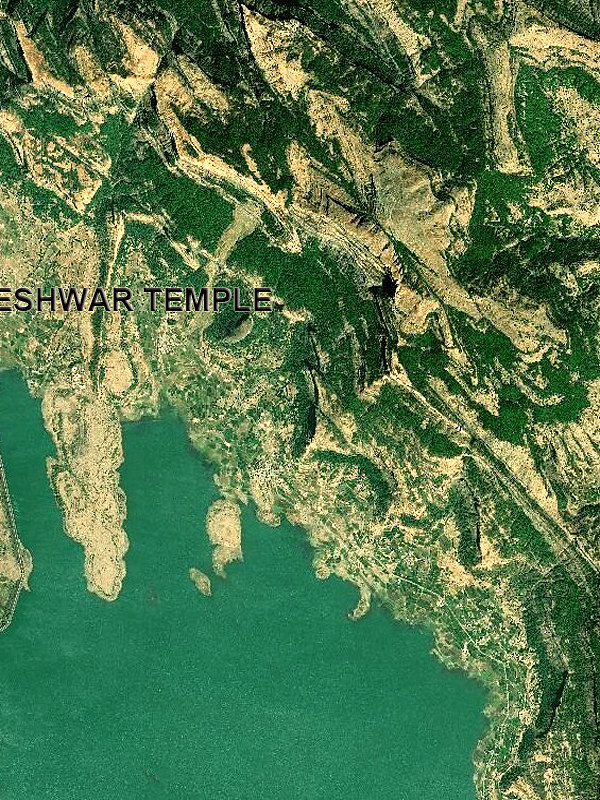 |
| |
| 2. NageshwarTemple region map, Pune district, Maharashtra, India |
| |
|
|
जुना व्यापारी घाटमार्ग माळशेज घाटात मार्गे कोकणातुन घाटावर म्हणजे दख्खन च्या पठारावर येतो. घाटमाथ्यावर खुबी आणि खिरेश्वर गाव आहेत. पुर्वेकडच्या व्यापारी बाजारपेठांपासुन हा मार्ग कल्याण, आणि सोपारा या बंदरांकडे जात होता. आज सुद्धा इथे झालेल्या नविन घाटरस्त्यामुळे कल्याण आणि अहमदनगर या शहरांना जोडणारा मार्ग आहे. पुष्पावती नदीचे खोरे सुपिक आहे.
|
|
The ancient trade route climbs up the western ghat ridge from the Konkan over to the Deccan plateau at Khubi. The ghat is known as Malshej ghat. Once atop Deccan plateau at Khubi, the trade route is aligned parallel to Pushpavati river. This ancient trade route was used to transport the goods from the eastern economic centers on the Deccan plateau to Kalyan and Sopara ports on the west coast of India. Today the modern Mumbai-Ahmednagar road passes through the same Pushpavati river basin, which was used for ancient trade in the past. The Pushpavati hill range is surrounded by fertile land.
|
|
|
| |
  |
| |
| 3. Nageshwar temple, Khireshwar village, Pune district, Maharashtra, India |
| |
|
|
खिरेश्वर दोन नद्यांच्या उगमस्थानी स्थित आहे आणि प्राचीन व्यापार मार्गाच्या जवळ आहे. या शिवाय ते हरिश्चंद्रगड खिंडीच्या जवळच आहे, ज्यास टोलार
खिंड म्हणतात. अहमदनगर जिल्ह्यातील अकोला तालुक्यात जाण्यासाठी हरिश्चंद्रगड डोंगरारांग ओलांडण्यासाठी टोलार खिंडीचा वापर केला जातो. या खिंडीतून सुमारे 20 कि.मी.पर्यंत प्रदक्षिणा टाळता येते. खिरेश्वर अर्थातच प्राचीन मंदिर असलेल्या हरिश्चंद्रगड किल्ल्याच्या पायथ्याजवळ आहे. नागेश्वर मंदिर काळू नदीच्या काठावर वसलेले आहे. या लहान मंदिरा जवळच एक लहान गुहा संकुल देखील आहे.
|
|
Khireshwar is located at the origin of two rivers, and is close to ancient trade route. Apart from these aspects it is also located close to the pass in Harishchandragadad range, called as Tolar khind. Tolar pass is used to cross the Harishchandragadad range to enter Akola Taluka of Ahmednagar district. This pass eliminates need to circumnavaigate by almost 20 km. Khireshwar is of course at the base of Harishchandragad fort, which has ancient temple. The Nageshwar temple is located on the banks of Kalu river, which after a travelling a mile from its place of origin, falls in to the gorge over the main ridge to enter Konkan. This small temple is also accompanied by a small cave complex nearby. In this photoessay ,let us see some details of the rock temple of Nageshwar.
|
|
|
| |
  |
| |
| 4. Nageshwar temple, Khireshwar village,, Pune district, Maharashtra, India |
| |
|
|
मंदिर आकाराने लहान आहे. मंदिर फांसणा शैलीचे आहे.
त्यात खूप छोटा मंडप आहे, ज्यामध्ये एकावेळी 10 पेक्षा जास्त लोक उभे राहू शकत नाहीत. मंडपाच्या दर्शनी भागामध्ये दोन खांब व दोन अर्धस्तंभ किंवा स्तंभ आहेत. या गर्भगृहात एक महादेव पिंडी आहे आणि ती स्थानिक पातळीवर नागेश्वर म्हणून ओळखली जाते. जवळच्या जंगलात सर्प मुबलक असल्यामुळे नागेश्वर हे नाव न्याय्य आहे. गर्भगृहाच्या प्रवेशद्वाराच्या शिखरावर शेषशायी विष्णूचे मोठे शिल्प आहे. मंडपाच्या छतात् अत्यंत् सुंदर् असे चित्रपाट् आहेत्. एकूण् १६ पट् आहेत्. यातील् १ पट् नश्ट् झाला आहे. उरलेल्या पटांपैकी ९ पट् त्यातल्या त्यात् सुस्थितीत् आहेत्. उरलेले ६ पट् भेगा पडल्यामुळे आणि पाण्यामुळे धुप होऊन् अंशत्: खराब् झाले आहेत्. या पटांमध्ये मुख्य देव् आणि दिक्पाल् (दिशांच् रक्षण् करणारे) देव् आहेत्. मुख्य् देवांमध्ये विष्णु, ब्रह्मा, गणेश्, कृष्ण्, स्कंद् यांचा समावेश् आहे. दिक्पालांमध्ये इंद्र, कुबेर्, वायु, वरुण्, अग्नि, निऋति, यम् यांचा समावेश् आहे.
|
|
The temple is small in size. It is built in Fansana style. It has a very small mandap, in which not more than 10 people can stand at a time. The facade of the mandap has two pillars and two semi pillars or pillasters. The garbhagriha has a Mahadev Pindi locally known as Nageshwar. Having abundant serpants in the forest nearby, the name Nageshwar is justified. On the top of the doorway to Garbhagriha, there is a large sculpure of Sheshashayi Vishnu. On the celing above in the Mandapa there is a beautiful array of sculpture plates or murals. Several Gods are depicted in these plate. These gods consist of main gods such as Vishnu, Brahma, Ganesh, Krishna, Skanda etc. and the guardians of directions such as Agni, Varun, Yama, Nirrutti, Vayu, Ishaan, Kuber and Indra. One of the 16 plates is completely damaged. About 9 plates are in relatively better state and are damaged to partial level, remaining 6 plates are considerabaly damaged
|
|
|
| |
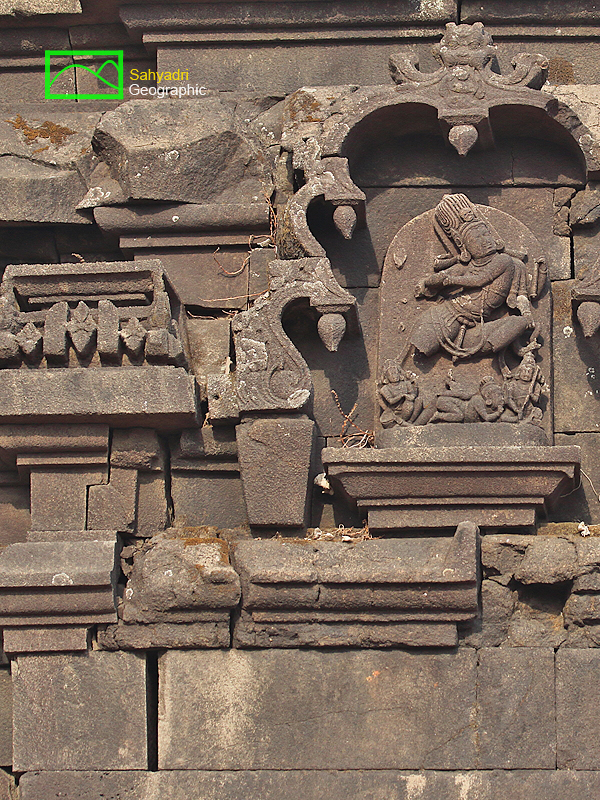  |
| |
| 5. Lord Shiva,Nageshwar temple, Khireshwar village, Pune district, Maharashtra, India |
| |
|
|
| |
  |
| |
| 6. Lord Shiva, Nageshwar temple, Khireshwar village, Pune district, Maharashtra, India
|
| |
|
|
| |
  |
| |
| 7. Sheshshayi Vishnu and Mahadev pindi ,Nageshwar temple, Khireshwar village, Pune district, Maharashtra, India
|
| |
|
|
शेषशायी विष्णू :
दरवाज्याच्या वरच्या बाजूला गर्भगृहाच्या पुढच्या भिंतीवर एक सुंदर शेषशायी विष्णूचे मोठे शिल्प आहे. विष्णू शेष नागावर झोपलेला आहे. ब्रह्म देव्, विष्णुच्या नाभीतुन् वर् आलेल्या कमळावर बसलेला आहे. शेष नागाचा चेहरा आणि हात दर्शविले आहेत. विष्णूच्या मस्तकाजवळ “श्री” आणि विष्णूच्या पायाजवळ “भु” दर्शविलेले आहेत. तसेच मधु आणि कैताभ दाखवले आहेत.
|
|
Sheshashayi Vishnu :
There is a beautiful sheshashayi Vishnu on the front wall of the Garbhagriha above the doorway. The Vishnu is in the sleeping pose on the Shesha naag. Brahma is sitting on lotus above his Nabhi. The face and hands of of the Shesh naga are shown. “Shree” near Vishnu’s head and “Bhu” near Vishnu’s feet is shown. Also Madhu and Kaitabh are shown.
|
|
|
| |
  |
| |
| 8. Sheshshayi Vishnu and Mahadev pindi , Nageshwar temple, Khireshwar village, Pune district, Maharashtra, India
|
| |
|
|
| |
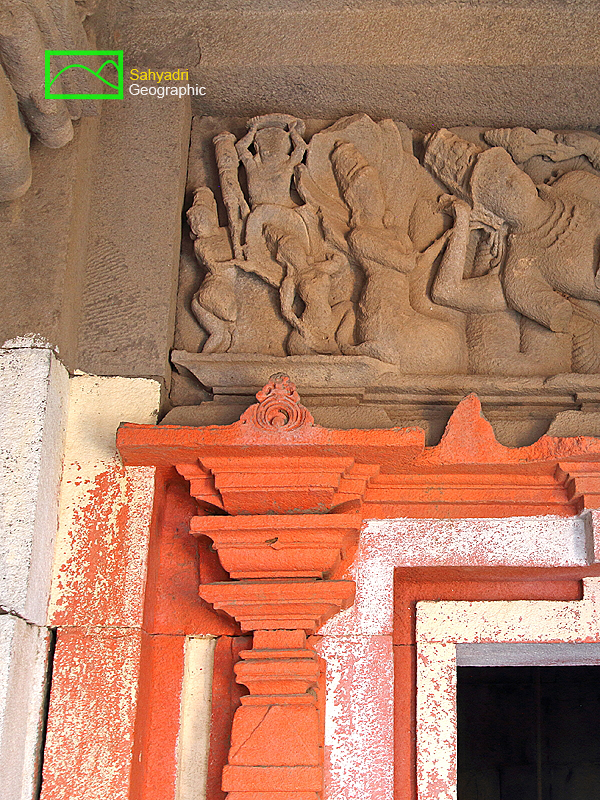  |
| |
| 9. Sheshshayi Vishnu , Nageshwar temple, Khireshwar village, Pune district, Maharashtra, India
|
| |
|
|
| |
  |
| |
| 10. Sheshshayi Vishnu,Nageshwar temple, Khireshwar village, Pune district, Maharashtra, India
|
| |
|
|
| |
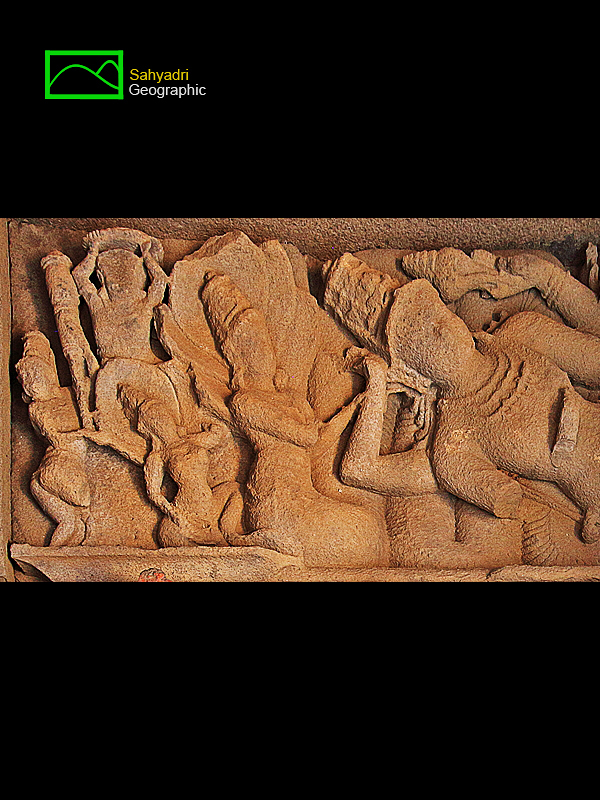  |
| |
| 11. Sheshshayi Vishnu, Nageshwar temple, Khireshwar village, Pune district, Maharashtra, India
|
| |
|
|
| |
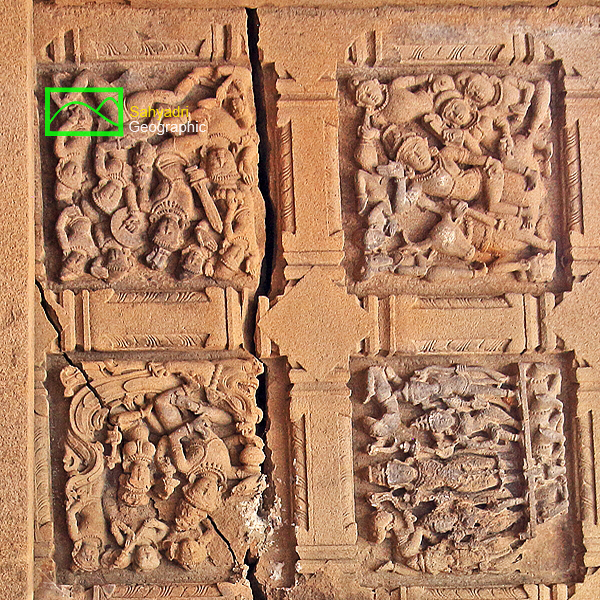  |
  |
| |
| 12. Sculpture plates in the ceiling, Nageshwar temple, Khireshwar village, Pune district, Maharashtra, India
|
| |
|
|
| |
  |
| |
| 12a. Sculpture plate in the ceiling, Nageshwar temple, Khireshwar village, Pune district, Maharashtra, India
|
| |
|
|
| |
  |
| |
| 12b. Sculpture plate in the ceiling, Nageshwar temple, Khireshwar village, Pune district, Maharashtra, India
|
| |
|
|
| |
  |
| |
| 12c. Sculpture plate in the ceiling, Nageshwar temple, Khireshwar village, Pune district, Maharashtra, India
|
| |
|
|
| |
  |
| |
| 12d. Sculpture plate in the ceiling, Nageshwar temple, Khireshwar village, Pune district, Maharashtra, India
|
| |
|
|
| |
  |
| |
| 12e. The arrangement of Sculpture plates in the ceiling, Nageshwar temple, Khireshwar village, Pune district, Maharashtra, India
|
| |
|
|
| |
  |
| |
| 13. Nirrutti with head in his hand and sword in his other hand, Sculpture plate in the ceiling, Nageshwar temple, Khireshwar village, Pune district, Maharashtra, India
|
| |
|
|
निऋति: निऋति राक्षस दक्षिण पश्चिम दिशेचा (नैऋत्य) संरक्षक आहे. त्याच्या गळ्यात दागिने आहेत.हातात तलवार आहे. त्याच्या दुसर्याl हातात एक मानवी डोके आहे. त्याच्याभोवती सात अप्सरा आहेत. नैऋत्य हा दक्षिण-पश्चिम दिशेला असलेला मराठी शब्द निऋति या शब्दापासून आला आहे.
|
|
Nirrutti : The Nirruti the rakshasa is the guardian of South west direction. He has ornaments in his neck. He is holding the human head in one of his four hands and the sword in his other hand. He is surrounded by seven apsaras. The marathi word for south west, “Nairutya” is derived from the name Nirrutti.
|
|
|
| |
 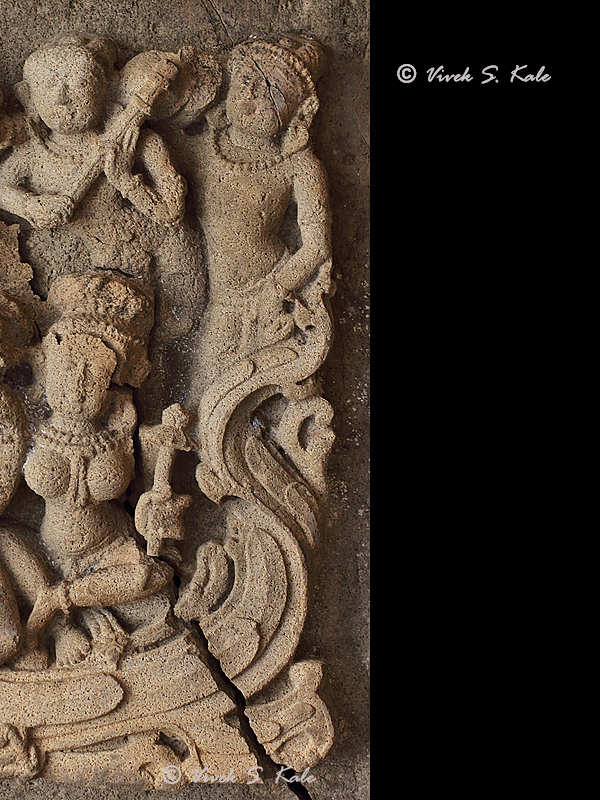 |
| |
| 14. Varun riding the crocodile, Sculpture plate in the ceiling, Nageshwar temple, Khireshwar village, Pune district, Maharashtra, India
|
| |
|
|
वरुण: वरुण हा वेदिक देवता आहे. वरुण पश्चिम दिशेचा संरक्षक आहे. त्याला मगरीवर स्वार असल्याचे दाखविण्यात आले आहे. तो पाण्याचे देव आहे. त्याच्या एका हातात त्याने कमळ पकडून दुसर्या हातात कमंडलू धरला आहे. त्याच्यासमवेत गंगा आहे. तो पश्चिम दिशेचा संरक्षक आहे.
|
|
Varun : Varun is the vedic god who is the guardian of west direction. He is riding the crocodile. He is the god of water. In one of his four hands he is holding lotus and in other handhe is holding kamandalu. He is accompanied by Ganga. He is guardian of west probabaly because of sea on the our west direction.
|
|
|
| |
  |
| |
| 15. Lord Vishnu, Nageshwar temple, Khireshwar village, Pune district, Maharashtra, India
|
| |
|
|
| |
 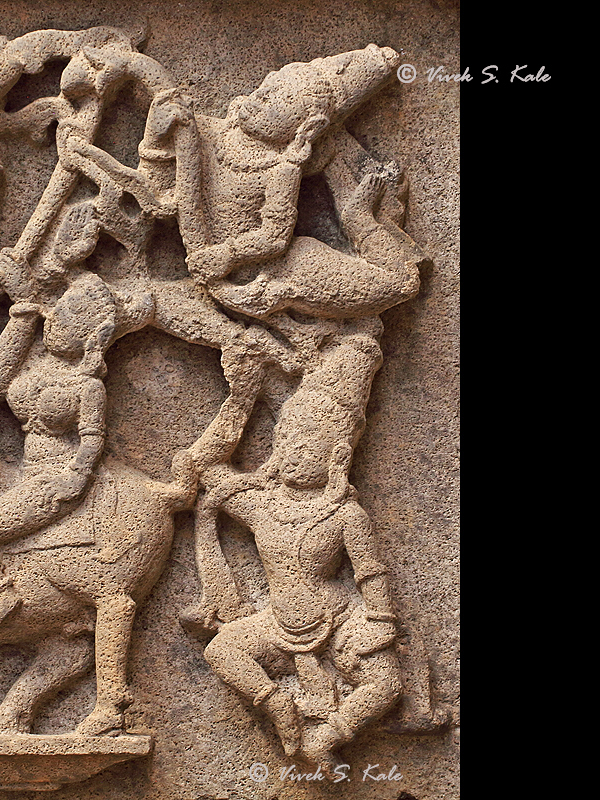 |
| |
| 16. Sculpture plate in the ceiling, Nageshwar temple, Khireshwar village, Pune district, Maharashtra, India
|
| |
|
|
वायुः वायु वैदिक देवता आहे. तो मृगावर स्वार आहे. त्याच्या एका हातात ध्वज आहे. तो उत्तर पश्चिम दिशेचा संरक्षक आहे. त्याच्यासमवेत त्याची शक्ती आहे. वायव्य हा उत्तर पश्चिम दिशेला असलेला मराठी शब्द वायु या शब्दापासून आला आहे.
|
|
Vaayu : Vaayu is the vedic god representing the wind. He is riding a dear and has flag in one of his four hands. He is the guradian of north west direction. The marathi word “Vayavya”, for north west is derived from the name Vaayu. He is guardian of north west, may be because of Western disturbance that enters india from that direction. He is accompanied by his Shakti.
|
|
|
| |
  |
| |
| 17. Lord Ganesh riding the mouse, Sculpture plate in the ceiling, Nageshwar temple, Khireshwar village, Pune district, Maharashtra, India
|
| |
|
|
गणेश: गणेश येथे उत्तर दिशेला दर्शविला गेला आहे. तो उंदीरावर स्वार आहे. त्याच्यासमवेत त्याची शक्ती आहे.
|
|
Ganesh : Ganesh is shown here on north direction. He is riding a mouse. He is accompanied by his Shakti.
|
|
|
| |
  |
| |
| 18. Kubera riding the goat, Sculpture plate in the ceiling, Nageshwar temple, Khireshwar village, Pune district, Maharashtra, India
|
| |
|
|
कुबेर: कुबेर बकरीवर स्वार आहे. तो उत्तर दिशेचा संरक्षक आहे. त्याने एका हातात कमळ धरले आहे. त्याच्यासमवेत त्याची शक्ती आहे.
|
|
Kubera : Kubera is riding the male goat and is the guardian of north direction. He is holding lotus in one of his hands. He is accompanied by his Shakti.
|
|
|
| |
  |
| |
| 19. Ishaan riding the bull, Sculpture plate in the ceiling, Nageshwar temple, Khireshwar village, Pune district, Maharashtra, India
|
| |
|
|
ईशान: जटाधारी ईशान आपल्या शक्तीसह बैलावर स्वार आहे. ईशान हे शंकराचे दुसरे नाव आहे. तो उत्तर पूर्व दिशेचा संरक्षक आहे. “ईशान्य” हे दिशेच नाव मराठीत वापरले जाते ते ईशान देवापासून आले आहे. त्याच्यासमवेत त्याची शक्ती आहे.
|
|
Ishan : Jatadhari Ishan is riding the bull with his shakti. Ishan is the name of Shankar, the Mahadev. He is the guardian of north east direction. The name “Ishanya” which is used in Marathi for north east is derived from the name of the god Ishan. He is accompanied by his Shakti.
|
|
|
| |
  |
| |
| 20. Lord Krishna, Nageshwar temple, Sculpture plate in the ceiling, Khireshwar village, Pune district, Maharashtra, India
|
| |
|
|
कृष्ण: कृष्ण पूर्वेला आहे. कृष्णाला दह्यांच्या मडक्यांबरोबर दाखवले आहे. त्याला बासरी वाजवतानासुद्धा दाखवले आहे आणि त्याच्या भोवती गोपीका आहेत.
|
|
Krishna : In this plate towards east, the direction of gods, Krishna is shown with pots of curd and also shown playing flute and is surrounded by the Gopikas.
|
|
|
| |
 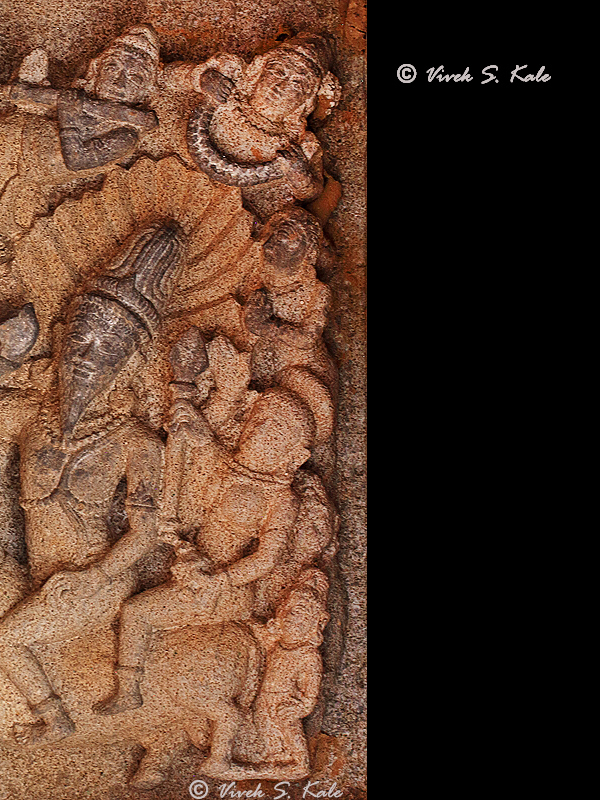 |
| |
| 21. Agni riding ram, Sculpture plate in the ceiling, Nageshwar temple, Khireshwar village, Pune district, Maharashtra, India
|
| |
|
|
अग्नि: अग्नि वेदिक देवता आहे. तो दक्षिण पूर्व दिशेचा संरक्षक आहे. आग्नेय हे दिशेच नाव अग्नी या देवताच्या नावावरून आले आहे. अग्नी येथे एड्क्यावर स्वार आहे. त्याच्या डोक्याच्या मागे ज्वाला आहेत. त्याच्या हातात शस्त्र आहे. त्याला दाढी आहे. त्याच्यासमवेत त्याची शक्ती आहे.
|
|
Agni : Agni is the vedic god who is the guardian of South east direction. The name Agneya which is used to denote south east directionis deirved from the name of this god. Agni is shown here riding on the ram (Edka). Flames are shown behind his head and is halding weapon in his hand. He is hown here with beard. He is accompanied by his Shakti.
|
|
|
| |
  |
| |
| 22. Kartikeya riding the peacock, Sculpture plate in the ceiling, Nageshwar temple, Khireshwar village, Pune district, Maharashtra, India
|
| |
|
|
कार्तिकेयन: कार्तिकेयन (स्कंद) मोरावर स्वार आहे. त्याचे तीन चेहरे दिसत आहेत. त्याच्या एका हातात शस्त्र आहे. येथे तो दक्षिण दिशेला दर्शविला आहे.
|
|
Kartikeyan : Kartikeyan, Skand ishsown here riding on peacock. His three of the faces can be seen. He is holding weapon in one of his hands. Here he is shown on south direction.
|
|
|
| |
  |
| |
| 23. Yama Dev riding the water buffalo, Sculpture plate in the ceiling, Nageshwar temple, Khireshwar village, Pune district, Maharashtra, India
|
| |
|
|
यम: यम रेड्यावर स्वार आहे. तो दक्षिण दिशेचा संरक्षक आहे. त्याच्यासमवेत त्याची शक्ती आहे. त्याच्या एका हातात दंडा आहे.
|
|
Yama : Yama here is shown riding the buffalo. He is the guardian of south direction. He is holding a danda in one of his hands. He is accompanied by his Shakti.
|
|
|
| |
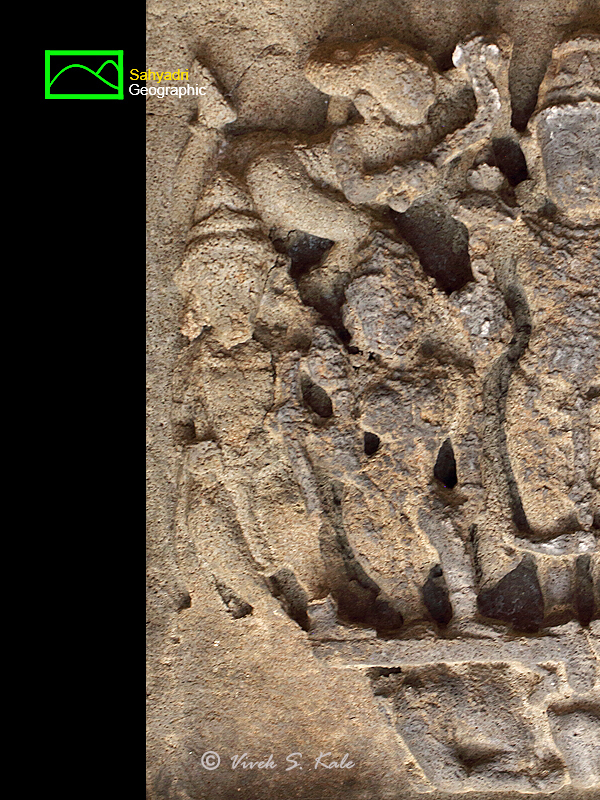 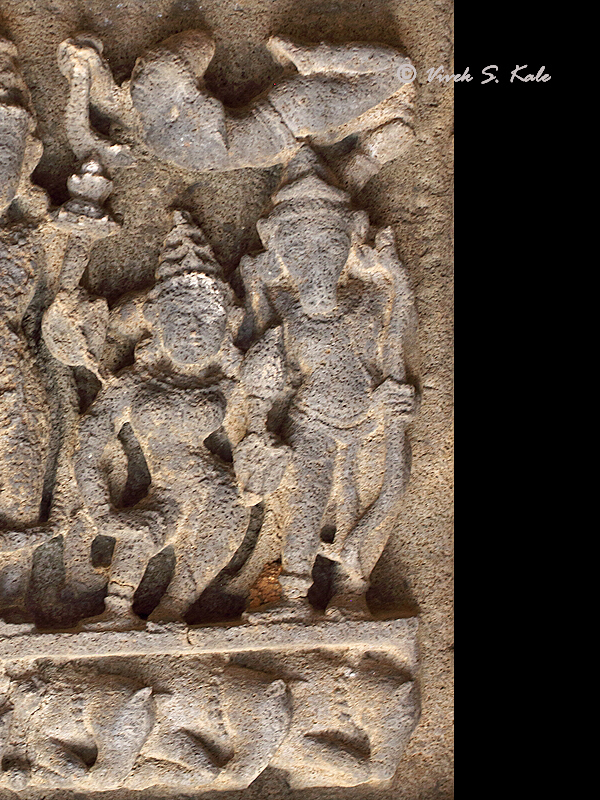 |
| |
| 24. Surya, Sculpture plate in the ceiling ,Nageshwar temple, Khireshwar village, Pune district, Maharashtra, India
a |
| |
|
|
सूर्य रथ चालवित आहे. रथाचे 4 घोडे आहेत. सूर्याने आपल्या हातात कमळांची फुले धरली आहेत.
|
|
Surya has been shown here riding the Ratha with 4 horses. He is holding twolotus flowers each in one of hishands.
|
|
|
| |
  |
| |
| 25. Nataraja Shiva, Sculpture plate in the ceiling, ,Nageshwar temple, Khireshwar village, Pune district, Maharashtra, India
|
| |
|
|
| |
 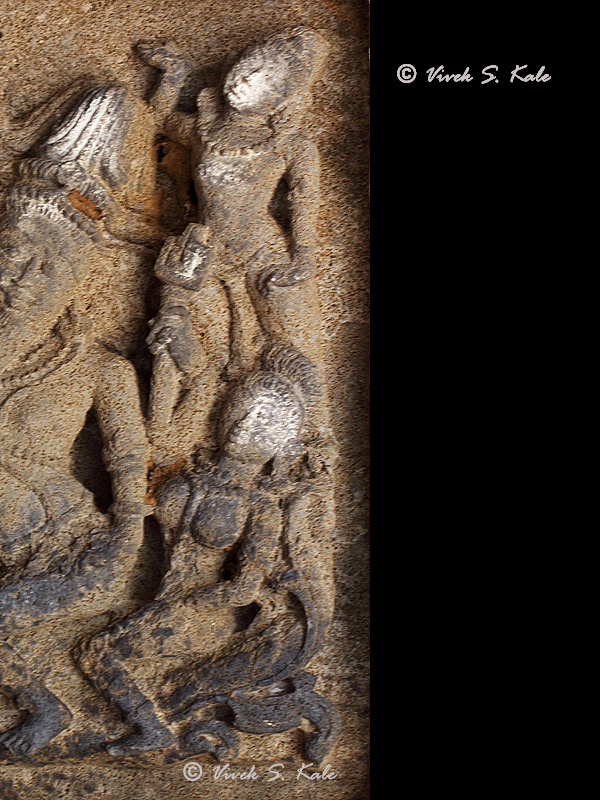 |
| |
| 26. Brahma dev riding parrot, Sculpture plate in the ceiling, Nageshwar temple, Khireshwar village, Pune district, Maharashtra, India
|
| |
|
|
ब्रह्मदेव: ब्रह्मदेव हंसावर स्वार आहेत. त्याने आपल्या हातात एक स्रुक (यज्ञ्याचा चमचा) धरला आहे. त्याचे तीन चेहरे दिसू शकतात. त्याच्यासमवेत त्याची शक्ती आहे.
|
|
Brahma :Brahma is shown here riding the hansa. He is holding sruk (a spoon used for Yagnya) in one of his hands. Three of his faces can be seen. He is accompanied by his Shakti.
|
|
|
| |
 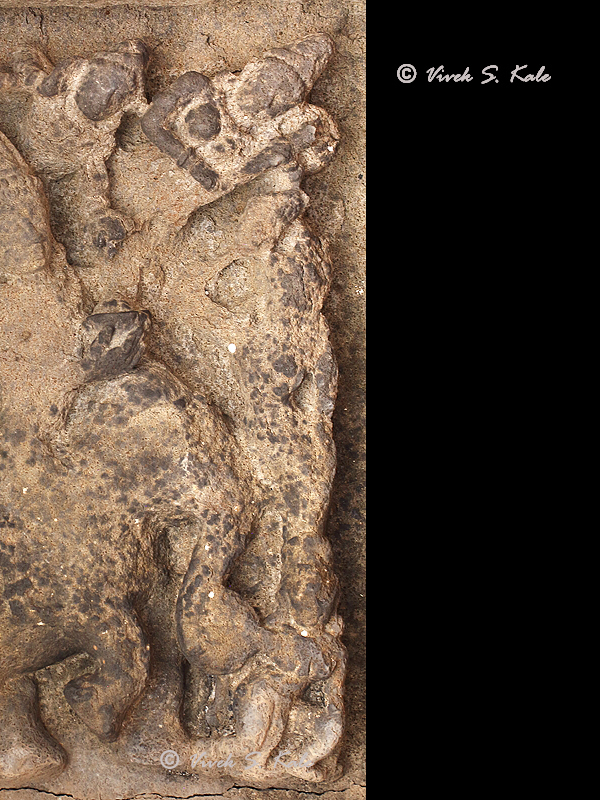 |
| |
| 27. Indra riding the elephant, Sculpture plate in the ceiling, Nageshwar temple, Khireshwar village, Pune district, Maharashtra, India
|
| |
|
|
इंद्र: प्रसिद्ध इंद्र येथे हत्ती ऐरावतवर बसलेला दिसतो. त्यांच्यासमवेत पत्नी इंद्राणी आहे. आणि त्यानी उजव्या हातात वज्र धरला आहे. तो पूर्व दिशेचा संरक्षक आहे.
|
|
Indra :The famous vedic god Indra is seen here riding the elephant Airavat. He is accompanied by wife Indrani and is holding the Vajra in his right hand. He is the guardian of East direction.
|
|
|
| |
  |
| |
| 28. Kiritmukha,Nageshwar temple, Khireshwar village, Pune district, Maharashtra, India
|
| |
|
|
| |
 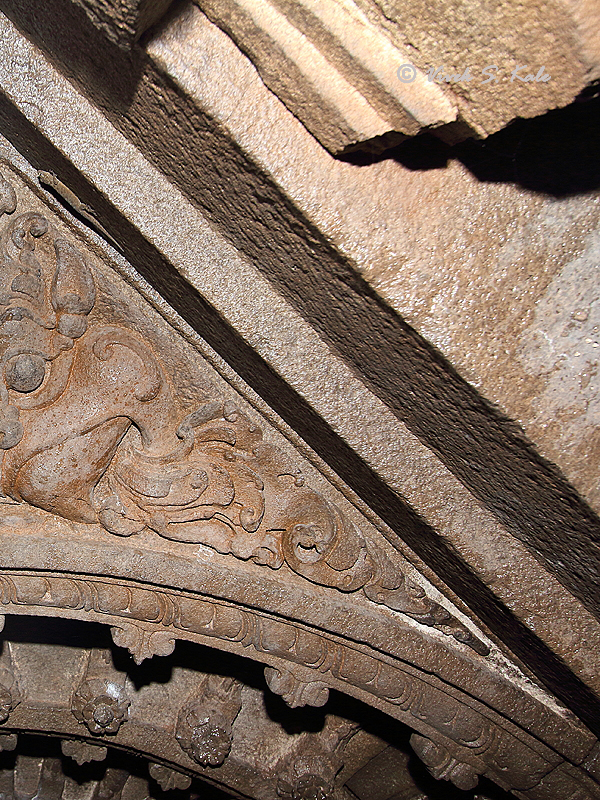 |
| |
| 29. Kiritmukha, Nageshwar temple, Khireshwar village, Pune district, Maharashtra, India
|
| |
|
|
| |
  |
| |
| 30. Kiritmukha, Nageshwar temple, Khireshwar village, Pune district, Maharashtra, India
|
| |
|
|
| |
 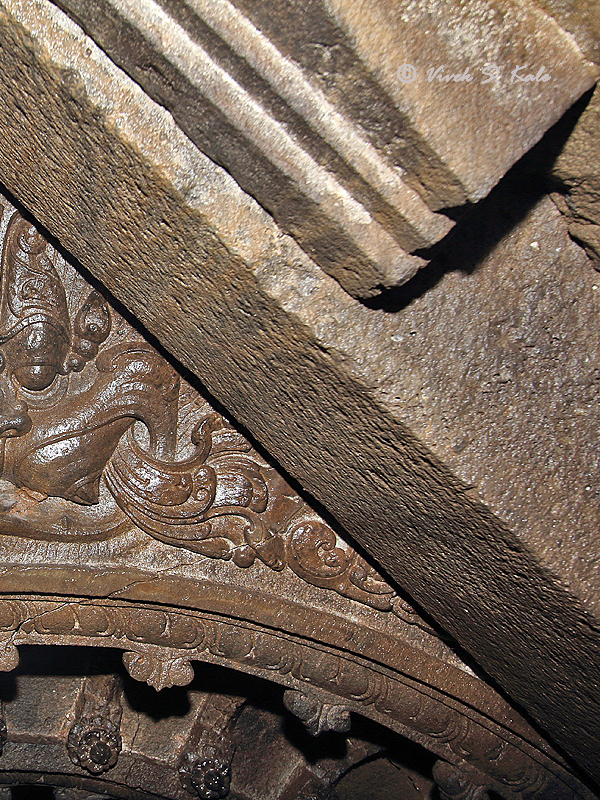 |
| |
| 31. Kiritmukha,Nageshwar temple, Khireshwar village, Pune district, Maharashtra, India
|
| |
|
|
| |
  |
| |
| 32. Nageshwar temple, Khireshwar village, Pune district, Maharashtra, India
|
| |
|
|
| |
 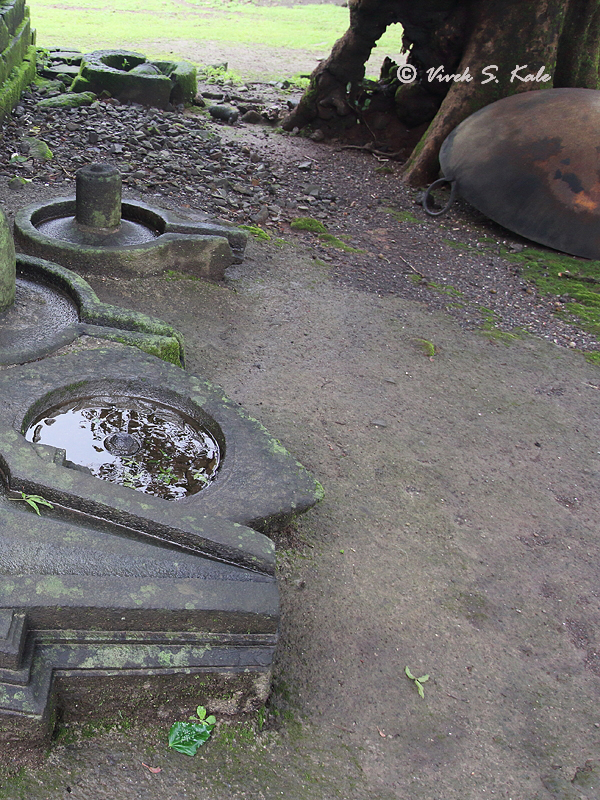 |
| |
| 33. Nageshwar temple, Khireshwar village, Pune district, Maharashtra, India
|
| |
|
|
| |
  |
| |
| 34. Nageshwar temple, Khireshwar village, Pune district, Maharashtra, India
|
| |
|
|
| |
  |
| |
| 35. Nageshwar temple, Khireshwar village, Pune district, Maharashtra, India
|
| |
|
|
| |
  |
| |
| 36. Nageshwar temple, Khireshwar village, Pune district, Maharashtra, India
|
| |
|
|
| |
 |
| |
|
|
References :
1. Murtividnyan- Dr. Ganesh Hari Khare,1939/2012.
2. Purasanchaya bhaag 1- Dr Arvind Jamkhedkar, 2016
|
| |
|
|
| |
|

























































































